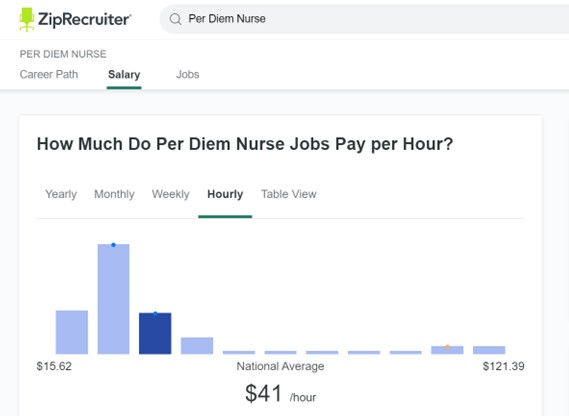The term “per diem” is Latin for “by the day.” And when it comes to the healthcare industry, per diem nursing is exactly that – working by the day.
So, what is per diem nursing?
Per diem nursing can best be compared to substitute teaching. Substitute teachers are called in to work, usually without much warning, to fill in for the normal teacher. The teacher might have an emergency, call in sick, or simply be on vacation and need someone to cover their classroom.
When a nurse has an emergency, calls in sick, or goes on vacation, they still have patients that need care and services that must be provided. And it doesn’t help that registered nurses are known to have some of the highest injury and illness rates in the healthcare and social assistance sector.1
That’s where per diem nursing comes in, to ensure that consistent care and medical services are provided whether it be in a hospital or long-term care facility. Per diem nursing is a critical role in health care facilities.
Per diem nurses work on an as-needed basis, sometimes for multiple facilities or a nursing staffing agency. They might pick up any available shift that comes their way or might only want to work on certain days of the week.
Income Protection for Nursing
Professionals

Income Protection for Nursing Professionals
The need for per diem nursing
Even before the pandemic, healthcare officials warned about the impending nursing shortage to come, citing a decrease in new nurses and an increase in an aging population. From 2011 to 2019, the 65+ population grew by 73%, from 41 million to 71 million people.2
Unfortunately, the pandemic exacerbated the already lack of nurses. Some hospitals and long-term care facilities were so short staffed during the pandemic that they had to mandate Covid-positive doctors and nurses to return to work, arguing that bringing back asymptomatic or even symptomatic staff is the only way they can keep their doors open amid a spike in hospitalizations.3
Even as we begin to return to some sense of normalcy, the necessity for more nurses remains.
Why do hospitals hire per diem?
Hospitals hire per diem nurses for one reason: they have to. If a hospital doesn’t have the proper number of staff, then they can’t provide their services to the community. Per diem nurses help fill in staffing gaps, make sure patients receive quality care, and maintain patient safety.
An understaffed workforce also puts undue strain on nurses and can negatively impact patient safety and quality of care. A 2019 study revealed that a patient’s risk of post-care-associated infection increased by 15% in facilities with low hospital staffing levels.4
Per diem nursing jobs
There isn’t just one type of per diem nursing which means that the possibilities are endless. You could be a per diem nurse practitioner in general surgery, a per diem registered nurse that rotates, or a per diem licensed practical nurse in internal medicine.
The one thing to remember about per diem nursing is that just because the role is per diem doesn’t mean that the requirements are any less than that of a full-time nurse in the exact same position. You are still required to have the same education, training, and licenses.
Per diem nursing salary
Since per diem nurses work by the day, their hourly pay is more relevant than their salary. And, even then, that can vary based on the location, position, and facility.
According to ZipRecruiter, the national average for per diem nursing is $41 an hour. But again, based on the chart below, that amount can vary.

(Image courtesy of ZipRecruiter)
Per diem vs pro re nata
“Pro re nata” is another Latin term that translates to “as the circumstance arises.” Per diem nursing is often confused with pro re nata (PRN) nursing, but the two have a distinct difference.
While PRN nurses similarly work on an as-needed basis, the difference is that PRN nurses work for a single health care facility and a specific medical unit. And, since they work for a specific unit, they have less flexibility for scheduling but may be eligible for benefits through their employer if they work enough hours. On the other hand, per diem nurses can work for multiple facilities at the same time but are not necessarily guaranteed work.
Disability Insurance for Nurses
Nurses work hard to take care of others – and disability insurance can help take care of you.
Per diem nursing vs travel nursing
Like per diem nurses, travel nurses are hired to work for a limited amount of time at a given location. Travel nurses temporarily relocate to different areas across the country to work at healthcare facilities with extended staffing needs, and on average work 13-week assignments in a single location.
Similarly, to per diem nurses, travel nurses get to choose where they want to work. However, a big difference is that travel nurses typically sign a contract and are guaranteed hours and a pay range.
For per diem nurses, shifts and pay are never a guarantee and are solely based on how many shifts you work.
Per diem nursing pros and cons
Working as a per diem nurse has both pros and cons. While it offers a ton of flexibility and a higher per hour earning potential, the uncertainty of when you work might not be for everyone. Understanding the potential benefits and drawbacks of per diem nursing is important for those considering it as a career option.
Pro: No set schedules
Per diem nurses have the freedom to build a schedule around their availability for any given week. They can turn down available shifts if they are unavailable or simply uninterested in the type of work.
A per diem nurse chooses where, when, and how often they work. This role may be ideal for someone that already has a full-time job but is looking to make some extra money, or perhaps a parent who is busy caring for their children but would still like to earn an income.
Con: No guarantee of work
While per diem nursing offers a ton of flexibility, they are not guaranteed shifts which means they are not guaranteed to earn a certain amount of money. Their opportunity to work is based on the needs of various employers and if that need is not there, a per diem nurse may go days or weeks without a shift.
Some people might be okay with inconsistent pay, while others pay need a guaranteed amount every two weeks to pay their bills.
The best way to ensure that a per diem nurse has ample opportunities to work could also depend on the amount of outreach they make to hospitals, nurse staffing agencies and other healthcare facilities.
Pro: High hourly wages
On a shift-by-shift basis, per diem nurses generally earn more than their full-time colleagues because of the urgency and last-minute nature of per diem nursing. Medical facilities use competitive hourly rates and attractive bonuses to ensure staff-to-patient ratios are being met, sometimes at the last minute.
Con: No employer-sponsored insurance
Since per diem nurses are not full-time employees and may work for various employers, they typically don’t receive employer-sponsored insurance and other benefits. As a result, per diem nurses should take into account the cost of individual health insurance and business insurance that is necessary to protect their income.
Pro and Con: Constantly changing environment
Per diem nurses have the opportunity to work for multiple employers across various clinical settings and regions, which can be exciting for someone who tends to get bored working in the same environment every day.
But, for some, the thought of an ever-changing work environment might be challenging if they prefer a routine and are more comfortable in a place that they know. Different employers and facilities have different policies and procedures and require you to adapt quickly.
Per diem nursing
Per diem nursing is a critical component of our healthcare system that also gives nurses the opportunity to choose where and when they work. Although this career path might not be for everyone, it offers a variety of benefits and freedoms many other careers do not.


